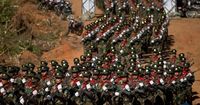After months of fierce conflict in Myanmar's northeast, the Ta'ang National Liberation Army (TNLA)—one of the country's major ethnic armed groups—has agreed to a ceasefire with the military government. The deal, brokered by China during talks in Kunming on October 27 and 28, 2025, marks a pivotal moment in the ongoing civil war, which has raged since the military's 2021 coup. The TNLA announced the agreement via a Telegram statement on October 29, 2025, signaling an uneasy pause in hostilities that have displaced thousands and threatened regional stability.
According to AP and The Irrawaddy, the ceasefire comes after intense pressure from Beijing, which has long held deep economic and strategic interests in Myanmar. China’s mediation reflects growing concerns over instability along its border with Myanmar, especially as fighting spilled into areas critical to cross-border trade. The talks were held in Kunming, a provincial capital about 400 kilometers from the Myanmar border, underscoring the proximity of the conflict to Chinese territory.
Under the terms of the ceasefire, the TNLA agreed to withdraw its troops from Mogok—a famed ruby-mining center in Mandalay Region—and Momeik (also known as Mongmit), a town in northern Shan State. While the TNLA did not specify a timeline for this withdrawal, the handover of these towns represents a significant concession. In exchange, Myanmar’s military pledged to halt ground offensives and airstrikes on TNLA-held territories in northern Shan State, a critical point given the rebels’ vulnerability to air attacks. The TNLA stated, "We will withdraw our troops from Mogok and Momeik as part of the agreement, but no timeline has been provided."
The ceasefire comes at a crucial juncture for Myanmar’s military government, which is preparing to hold elections in two phases on December 28, 2025, and January 11, 2026. Critics, as reported by AP, argue that the polls are designed to legitimize and entrench military rule, particularly as the main opposition parties remain excluded from the process. The deal with the TNLA allows the military to stabilize large swaths of Shan State ahead of voting, reducing the threat of disruption from ethnic armed groups.
The TNLA is a member of the Three Brotherhood Alliance, which also includes the Myanmar National Democratic Alliance Army (MNDAA) and the Arakan Army. Since launching Operation 1027 in October 2023, this alliance has fought for greater autonomy from Myanmar’s central government and has captured significant territories near the Chinese border. The operation initially saw the alliance expel the military from much of northern Shan State, including the capture of Lashio—the de facto capital of the region and home to the military’s Northeast Regional Command—by the MNDAA in August 2024.
However, the tide began to turn in 2025. As The Irrawaddy details, China intensified pressure on the TNLA and MNDAA to halt their advances, fearing the collapse of Myanmar’s junta and the ensuing chaos along its border. Beijing shut border crossings, cut off internet, fuel, and electricity supplies to rebel-held regions, and pressured the United Wa State Army to end support for the TNLA and MNDAA. The MNDAA eventually reached its own ceasefire with the junta in January 2025, withdrawing from Lashio in April under Chinese supervision.
Meanwhile, the Myanmar military launched a series of offensives, retaking Nawnghkio in July 2025, followed by Kyaukme and Hsipaw in October—three strategic towns on the highway linking Mandalay to the Chinese border. These victories allowed the military to reopen vital trade routes after nearly two years of disruption. The TNLA’s withdrawal from Mogok and Momeik, announced in the latest ceasefire, further consolidates the military’s regained position in northern Shan State.
According to UNB citing AP, the ceasefire is widely seen as a strategic gain for Myanmar’s military government. It not only reverses most of the territorial gains made by the TNLA during Operation 1027 but also buys the junta time and space to hold its planned elections with less risk of armed interference. The TNLA, for its part, has been battered by near-daily airstrikes and infantry attacks, making the ceasefire a pragmatic—if reluctant—move to preserve its remaining strength.
The longer-term outlook, however, remains uncertain. As The Irrawaddy points out, this ceasefire, like many before it, is more about managing the conflict than resolving it. The TNLA and its allies continue to seek greater autonomy and remain loosely aligned with pro-democracy resistance groups that emerged after the 2021 coup. The military, meanwhile, is eager to project an image of stability as it pushes ahead with elections that many believe will only entrench its rule.
China’s role as mediator cannot be understated. With major economic projects—including pipelines and infrastructure linking Yunnan province to the Indian Ocean—Beijing has every incentive to prevent chaos along its southwestern frontier. Yet, its balancing act between supporting Myanmar’s junta and maintaining relations with ethnic armed groups is fraught with challenges. The latest truce highlights both China’s leverage and the fragility of peace in the region.
For ordinary people in northern Shan State and Mandalay Region, the ceasefire brings a measure of relief after months of relentless violence. Towns like Mogok and Momeik, famous for their gemstones but battered by conflict, now face the uncertain prospect of military reoccupation. The reopening of highways and trade routes may restore some economic activity, but the scars of war—and the deep-seated grievances that fuel it—remain unresolved.
As Myanmar’s military government prepares for its controversial elections, the world will be watching to see whether the ceasefire holds and whether it leads to any meaningful progress toward peace. For now, the agreement stands as a testament to the complex interplay of local ambitions, regional geopolitics, and the enduring quest for autonomy in one of Southeast Asia’s most turbulent corners.
The coming months will reveal whether this latest ceasefire is merely a pause in the conflict or the first step toward a more lasting settlement. For now, at least, the guns have fallen silent—if only for a while.

